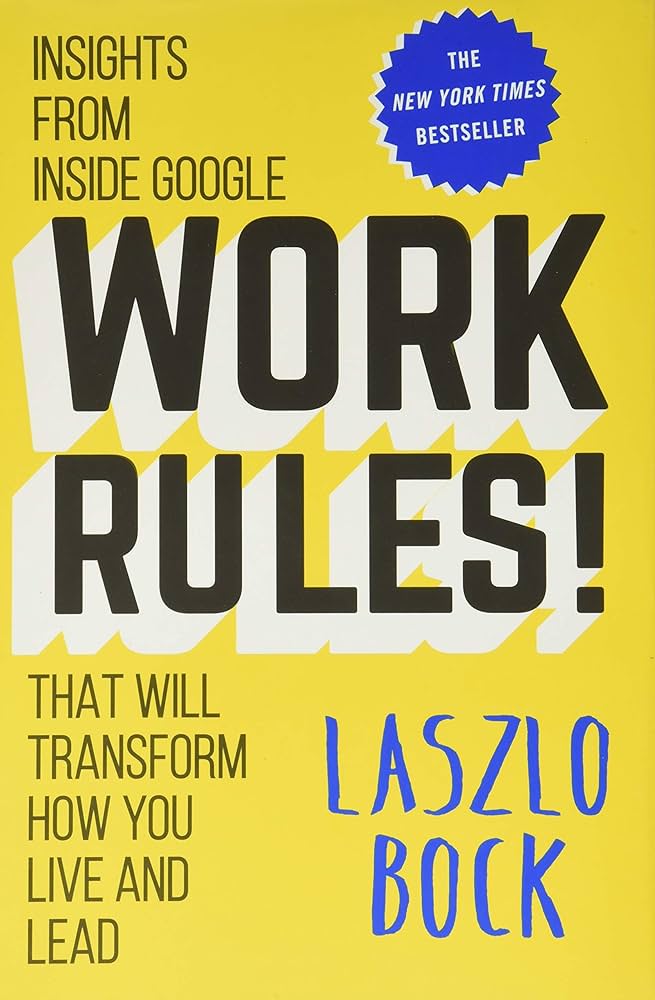Work Rules!: Insights from Inside Google That Will Transform How You Live and Lead
RATING


“Work Rules” is authored by Laszlo Bock – a businessman, consultant, start-up founder, and, most importantly, a former Senior Vice President of People Operations at Google.
The book deals with the question of corporate culture and all its components — management, hiring, promotions, pay, etc. — using the example of Google’s innovative culture and its myriad of following successes. The author meticulously depicts each part of the internal corporate culture with great detail, devoting chapters to subjects such as general management, hiring process, employee compensation and benefits, training and development, talent retention, performance metrics, etc. He opens and closes the book with chapters devoted to the history of Google, describing how the company evolved and how the practices and methods outlined in the book helped it to achieve its current impressive status.
Everything Bock writes stems from his Lockean belief that people are fundamentally good and should be given opportunities to thrive at the company, become the best versions of themselves — and, ultimately, the best workers. This principle changes fundamentally the approach to corporate culture and can be used to enhance many spheres, practices, and policies at any company.
As such, more empowerment should be given to the employees, and, simultaneously, the dominating positions of managers should be reduced. The employees should have freedom to pursue their own goals and tasks (Google allows 10-20% of their working hours for that), should not be afraid to propose their ideas and solutions, and have the right to challenge virtually anyone so that everyone can achieve the best results. Bock explains that most decisions in Google are made by committees and rely on “wisdom of the crowds” – largely influenced by the constant streams of information and feedback made by all Googlers. In such a way, corporate culture becomes more transparent, and the decisions are made with full knowledge of teams.
In the same vein, the author rejects the idea of routinely firing underperforming employees that is present in many modern firms, as it undermines the efforts of the HR departments, lowers the employee morale, and leads to squabbles within the teams and money losses. Instead, he proposes to give such employees a chance, focusing on improving them with constructive feedback. Only when they fail completely should they be relieved. The high achievers, on the other hand, should be praised, promoted and overpaid relentlessly, even if it causes some levels of discomfort to “average” employees.
In terms of hiring and training, Bock firmly believes that most modern company training is useless, and instead promotes hiring only the best of the best, no matter how much it takes. The training process, in their case, should involve coaching, mentoring, and learning by example, and not your typical corporate courses. Overall, the author states that the company’s mission, the thrill of a challenge and a pleasant working atmosphere should be the main stimulants for the employees to improve and succeed.
The book is written very thoughtfully and is entertaining to read. The author only sparingly uses personal anecdotes — the most common type of arguments found in many books on business — instead choosing to rely on a variety of examples from various disciplines such as economy, history, management theory, psychology, sports, cult videogames such as “Planescape: Torment”, and many others. These examples reinforce the author’s points and make the book more intellectually engaging and educative to read.
The book is overall very focused, in-depth, and can be considered a comprehensive instruction on enhancing a company’s culture. Laszlo Bock clearly demonstrates that he has the vision, knowledge, and experience to back up his claims. He does not waste his time straying away from the topic of the book — corporate culture — to discuss less relevant matters such as personal development, search of yourself and other cliché topics all too common in business literature.
In general, most of the advice the author gives is very useful, and, as of 2023, its applications can easily be seen throughout the business world. Google’s management culture with its empowered employees and entrenched horizontality is especially popular and is proven to create better working environments and improve performance.
Finally, Bock’s main thesis – that people are fundamentally good, and you should trust your employees – is an incredibly powerful message and a good lesson not only to technology businesses, but to any organization that relies on collaboration and productivity.
The advice given by Mr. Bock in regard to hiring employees can be thought of as somewhat dated and only realistically appliable to software or other predominantly “white-collar” industries, and especially larger companies in these fields. For example, his approach to hiring for “as a long as it takes” to find a “superstar employee” may work for Google with its gigantic revenues, but not for smaller companies and even most of non-white collar corporations. It also does not apply to markets with lower competency levels where the availability of “expert” workers can be much lower.
His thesis that company training is almost completely useless, and that you should overpay and overpraise the best performers can be considered controversial and fairly dated, especially in times of rising dissatisfaction of the young people with their job and life prospects — examples being “Great Resignation” in the US and West in general, Tang Ping (“Lying flat”) in China. In general, while he describes the hiring process from the perspective of the company and its inner workings in great detail, he offers little advice on how to actually *attract* the best employees. Google may be getting millions of applications, but what about smaller firms?
Another note on corporate training: While we could agree that most corporate training programs do not provide the value that they could, structured education programs are necessary in markets or industries with lower competency levels, less exposure to global best practice, and potentially require re-skilling of large portions of the workforce.
Finally, Bock’s acknowledgement, albeit relatively minor, of the existence of nepotism problems in Google and many other corporations and its negative impacts is, of course, laudable, but it almost feels like he should have gone farther and explained it in better detail.
From the visionary head of Google’s innovative People Operations comes a ground-breaking inquiry into the philosophy of work — and a blueprint for attracting the most spectacular talent to your business and ensuring that they succeed.
“We spend more time working than doing anything else in life. It’s not right that the experience of work should be so demotivating and dehumanizing.” So says Laszlo Bock, former head of People Operations at the company that transformed how the world interacts with knowledge.
This insight is the heart of “Work Rules!”, a compelling and surprisingly playful manifesto that offers lessons including:
- Take away managers’ power over employees
- Learn from your best employees-and your worst
- Hire only people who are smarter than you are, no matter how long it takes to find them
- Pay unfairly (it’s more fair!)
- Don’t trust your gut: Use data to predict and shape the future
- Default to open-be transparent and welcome feedback
- If you’re comfortable with the amount of freedom you’ve given your employees, you haven’t gone far enough.
Drawing on the latest research in behavioural economics and a profound grasp of human psychology, “Work Rules!” also provides teaching examples from a range of industries-including lauded companies that happen to be hideous places to work and little-known companies that achieve spectacular results by valuing and listening to their employees. Bock takes us inside one of history’s most explosively successful businesses to reveal why Google is consistently rated one of the best places to work in the world, distilling 15 years of intensive worker R&D into principles that are easy to put into action, whether you’re a team of one or a team of thousands.
“Work Rules!” shows how to strike a balance between creativity and structure, leading to success you can measure in quality of life as well as market share. Read it to build a better company from within rather than from above; read it to reawaken your joy in what you do.
“Work Rules!” is primarily directed towards CEOs, managers, and corporate officers looking to work on and improve their firms’ corporate cultures and processes. It can also be recommended to a wider audience of people that are curious about Google, Silicon Valley, corporate culture, management, and business in general.
If you are looking for more excellent books on corporate culture, “No Rules Rules!” (2020) by Reed Hastings also has quite an interesting take on corporate culture from inside of Netflix. Check out our review!

The book is multi-dimensional and comprehensive — it is particularly devoted to strategic and tactical application of Google’s successful practices but delves also (and provides examples of) performance metrics and other measurements.
See content on this topic


Understand the value of a customer-oriented analytics package and how behavioral scenarios can be used to improve profitability through influencing behavior and usage.
To understand the principles of game dynamics and learn how to effectively use the elements of gamification in business: to involve customers, employees and contractors in the process.
Understanding branding and communications from the standpoint of emotional engagement and building relevant and meaningful dialogue with customers.
This course covers a complete view of customer touch points (both physical and virtual) and a unique model for standardizing and managing customer contact models across channels including approaches for customer feedback, quality management, and migration.
Experiential Branding & Communications – Improving Brand Integration Through Emotional Engagement.
This course covers a complete view of customer touch points (both physical and virtual) and a unique model for standardizing and managing customer contact models across channels.
Sales training for front line along with basic development and coaching principles for line management.
Understanding how leaders must evolve with relation to the evolution of business models, new management models, and the significant changes to the workforce with Digital Natives now making up more than 50% of the workforce globally.
Understand the theory and mechanics of developing and managing a customer-centric and experience-driven corporate culture that is consistent and stable and includes elements of Employee Experience (EX) and Employee Relationship Management (ERM).
Understanding the evolution of leadership styles, management models, organizational structures, performance measurement and guiding change in the evolution of business models from product-centric to customer-centric and even relationship-centric.
Understand how to manage both internal and external digital transformation while considering the landscape for digital business models and the effect on traditional business models. Understanding organizational readiness for transformation and the role of corporate culture in managing transformations.
The changes in consumer behavior, employee behavior, and the evolution of business models in the digital age cause significant difficulties and imperatives for leaders who must develop new skills and evolve their leadership styles to be effective in this fast changing, challenging, and competitive environment.
Understanding how leaders must evolve with relation to the evolution of business models, new management models, and the significant changes to the workforce with Digital Natives now making up more than 50% of the workforce globally.
Understand how to manage both internal and external digital transformation while considering the landscape for digital business models and the effect on traditional business models. Understanding organizational readiness for transformation and the role of corporate culture in managing transformations.
The changes in consumer behavior, employee behavior, and the evolution of business models in the digital age cause significant difficulties and imperatives for leaders who must develop new skills and evolve their leadership styles to be effective in this fast changing, challenging, and competitive environment.
Understanding how to design & manage change/transformation programs in organizations of different sizes. This course will help any size team or organization to better deal with change & transformation on any scale.




 Copy Link
Copy Link
 E-mail
E-mail
 LinkedIn
LinkedIn
 Facebook
Facebook
 Telegram
Telegram
 WhatsApp
WhatsApp
















 Go Back
Go Back
Leave a Reply
You must be logged in to post a comment.